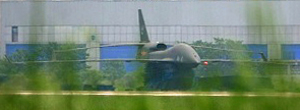Engineering:Guizhou Soar Dragon
| Soar Dragon | |
|---|---|

| |
| Role | HALE unmanned aerial vehicle |
| National origin | People's Republic of China |
| Manufacturer | Guizhou Aircraft Industry Corporation |
| Designer | Chengdu Aircraft Industry Group |
| Introduction | 2015-16[1] |
| Status | In production[2] |
| Primary user | People's Liberation Army Air Force |
| Number built | 16[1][3] |
The Guizhou Soar Dragon (Chinese: 翔龙; pinyin: xiáng lóng), military designation WZ-7,[4] is an unmanned aerial vehicle of the High-Altitude Long Endurance (HALE) type, featuring an unusual joined, tandem wingplan. (As of 2011) it is being developed by the People's Republic of China for reconnaissance and possible anti-shipping missions.
Design and development
The Soar Dragon, designed by the Chengdu Aircraft Industry Group and constructed by the Guizhou Aircraft Industry Corporation for service with the People's Liberation Army Air Force , was originally displayed as a model at the Zhuhai Air Show in 2006.[5] Optimised for long-endurance missions at high altitude, the aircraft features an unusual tandem, joined wing platform.[6] Except for the wing and the configuration of vertical stabilizers, the Soar Dragon is similar in appearance and mission to the Northrop Grumman RQ-4 Global Hawk operated by the United States Air Force .[6]
Large by the standards of UAVs, the Soar Dragon's joined wing allows for a more rigid, less flexible wing than other configurations, with benefits said to include an increased lift-to-drag ratio and less complex flight controls than a HALE UAV with a conventional wing would require.[5] The aircraft is powered by a Guizhou WP-13 turbojet engine, a copy of the Soviet Tumansky R-13; it is anticipated that a newer, improved engine, will be installed in production aircraft.[5] The air intake for the engine is mounted atop the fuselage, with the engine itself mounted in the rear of the aircraft.[5]
Operational history
As of 2011, the Soar Dragon was not known to have yet conducted its maiden flight, however it was undergoing radar cross-section and other electromagnetic tests in anticipation of flight testing.[5]
In service with the PLAAF, the primary mission of the Soar Dragon is expected to be aerial reconnaissance, but it is anticipated that the aircraft will also be fitted with sensors suitable for designating naval vessels for targeting by anti-ship ballistic missiles and cruise missiles.[6]
Since 2018, seven Soar Dragons and supporting infrastructure have spotted at three bases: three each at Shigatse Airbase in the Tibet Autonomous Region and Lingshui Air Base on Hainan Island (near the South China Sea), and two at Yishuntun Airbase.[7]
On July 24, 2019, a Soar Dragon followed an American Ticonderoga-class cruiser, the USS Antietam as it transited the Taiwan Strait, marking its first operational use. As of 2019, the Soar Dragon is operated from three strategic sites: an airbase in Jilin province, Yishitung near Tibet and Lingshui on Hainan Island.[8]
Variants
- Soar Dragon
- The original name and variant.
- WZ-7
- Military variant.
Operators
 People's Republic of China
People's Republic of China
- People's Liberation Army Air Force : 8 units[1]
- People's Liberation Army Naval Air Force : 8 units[3]
Specifications
Data from AirForces Monthly[5]
General characteristics
- Crew: None
- Length: 14.33 m (47 ft 0 in)
- Wingspan: 24.86 m (81 ft 7 in)
- Height: 5.41 m (17 ft 9 in)
- Powerplant: 1 × Guizhou WP-13 turbojet, 43.1 kN (9,700 lbf) thrust
Performance
- Cruise speed: 750 km/h (466 mph, 405 kn)
- Range: 7,000 km (4,300 mi, 3,800 nmi)
- Combat range: 2,000 km (1,200 mi, 1,100 nmi)
- Endurance: 10 hours
- Service ceiling: 18,000 m (59,000 ft)
- Thrust/weight: 5.8
See also
Aircraft of comparable role, configuration and era
- BAE Systems Mantis
- CAIG Sky Wing
- Northrop Grumman RQ-4 Global Hawk
Related lists
References
- ↑ 1.0 1.1 1.2 Rupprecht, Andreas. Modern Chinese Warplanes:Chinese Air Force - Aircraft and Units. Harpia Publishing. p. 106. ISBN 978-09973092-6-3.
- ↑ "Satellite imagery shows build-up near Doklam". The Hindu. 27 January 2018. http://www.thehindu.com/news/national/satellite-imagery-shows-build-up-near-doklam/article22537847.ece.
- ↑ 3.0 3.1 Rupprecht, Andreas (2018). Modern Chinese Warplane: Chinese Naval Aviation - Aircraft and Units. Harpia Publishing. p. 36. ISBN 978-09973092-5-6.
- ↑ Joe, Rick (27 November 2019). "China's Growing High-End Military Drone Force". The Diplomat. https://thediplomat.com/2019/11/chinas-growing-high-end-military-drone-force/.
- ↑ 5.0 5.1 5.2 5.3 5.4 5.5 Parsons, Gary, ed (September 2011). "News Headlines: Has China Unveiled Its Soar Dragon?". AirForces Monthly (London: Key Publishing) (282): 4–5.
- ↑ 6.0 6.1 6.2 Newdick, Thomas, ed (September 2011). "World News: China's Soar Eagle UAV revealed". Combat Aircraft (Hersham, Surrey, UK: Ian Allan Publishing) 12 (9): 30. ISSN 2041-7489.
- ↑ "Soar Dragon UAVs Deploy to Yishuntun Airbase". 23 March 2018. https://www.bellingcat.com/news/rest-of-world/2018/03/23/soar-dragon-uavs-deploy-yishuntun-airbase/.
- ↑ Axe, David (29 July 2019). "China’s Giant Spy Drone Just Tailed a U.S. Navy Cruiser". https://nationalinterest.org/blog/buzz/china%E2%80%99s-giant-spy-drone-just-tailed-us-navy-cruiser-69881.


